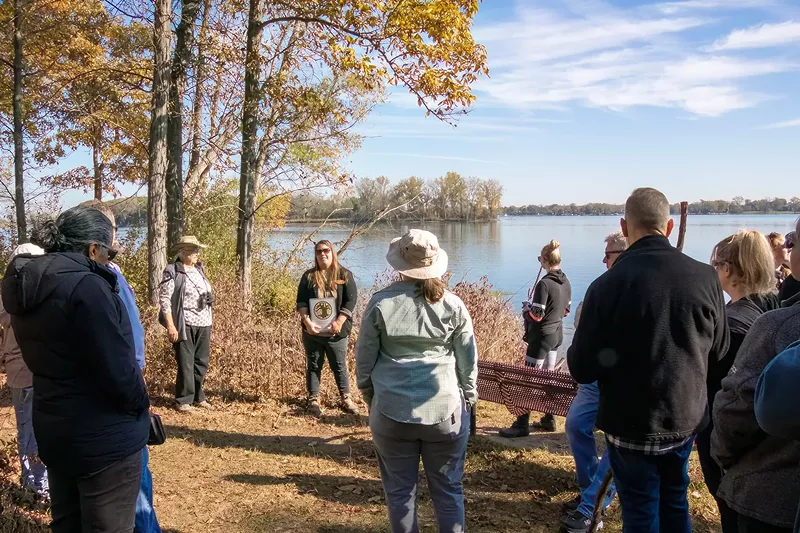Detroit River refuge’s ancient forest gets national recognition
The refuge’s inclusion in the Old-Growth Forest Network underscores the importance of preserving natural spaces for public enjoyment and biodiversity

Audio By Carbonatix
[
{
"name": "GPT - Leaderboard - Inline - Content",
"component": "35519556",
"insertPoint": "5th",
"startingPoint": "3",
"requiredCountToDisplay": "3",
"maxInsertions": 100,
"adList": [
{
"adPreset": "LeaderboardInline"
}
]
}
]

The Detroit River International Wildlife Refuge has achieved a significant milestone: The Humbug Marsh Unit in Gibraltar has officially joined the Old-Growth Forest Network, a national collection of protected native forests where people can experience biodiversity and the beauty of nature.
A celebratory event took place on Oct. 20, marking the induction of the marsh into this prestigious network.
Attendees joined a guided hike along the 2.25-mile Green Trail, led by Great Lakes Regional Manager Leona Addie and Park Ranger Alex Gilfrod. Along the way, participants explored the unique ecological features of Humbug Marsh and learned to identify characteristics of old-growth forests, including trees more than 300 years old.
“The old-growth forest makes up 32.24 acres of the larger 405.16-acre Humbug Marsh Unit,” said Gilford. “It’s a special place where the public can get up close and personal with ancient oak trees and be inspired by this protected natural gem in the downriver area.”
Humbug Marsh has long been a beacon of conservation efforts. In 1998, a proposed development threatened to destroy the last remaining mile of natural shoreline on the U.S. side of the Detroit River. In a powerful display of community action, more than 1,000 local residents rallied in Gibraltar to oppose the project, successfully preserving the marsh.
This victory ultimately led to the addition of Humbug Marsh to the refuge in 2004 and continues to serve as a testament to the community’s commitment to conservation.
“The broad support for the refuge has been instrumental in building awareness and ensuring ongoing efforts to protect wildlife and habitat,” Addie said.
Humbug Marsh is recognized for its ecological importance. In 2010, it was designated Michigan’s first Wetland of International Importance under the Ramsar Convention on Wetlands. The marsh’s wet mesic flatwood habitat is rare in Michigan, featuring shagbark hickory, oak, ash, and elm trees. Its coastal wetlands, influenced by fluctuating Great Lake water levels, provide critical habitat for rare fish and wildlife species.
“This ever-changing habitat is a major repository of species and plays a vital role in preserving ecosystem processes,” Addie said.
The addition of Humbug Marsh to the Old-Growth Forest Network ensures this remarkable area will continue to inspire and educate future generations while safeguarding its ecological treasures, officials said.
The refuge’s inclusion in the Old-Growth Forest Network underscores the importance of preserving natural spaces for public enjoyment and biodiversity. For visitors, Humbug Marsh offers a rare opportunity to explore ancient forests and understand the dynamic interplay of habitats that make Michigan’s ecosystems unique.
With its long history of community-driven conservation and ecological significance, Humbug Marsh remains a shining example of what can be achieved when people come together to protect the environment, according to the U.S. Fish and Wildlife Service.






